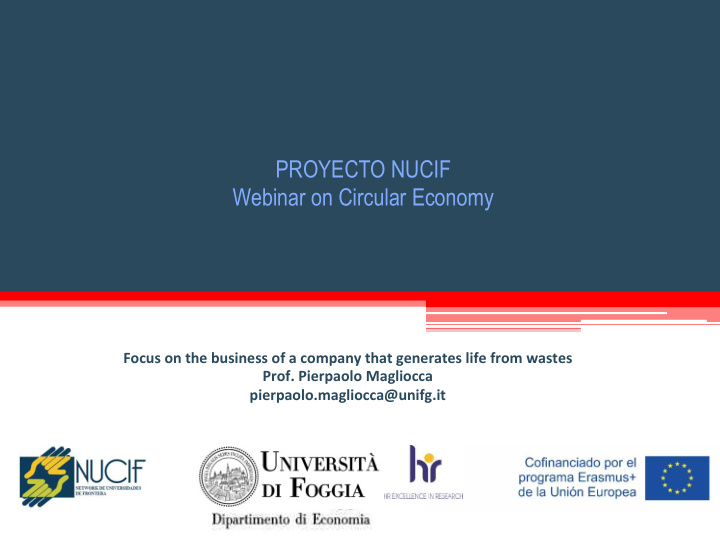



PROYECTO NUCIF Webinar on Circular Economy Focus ¡on ¡the ¡business ¡of ¡a ¡company ¡that ¡generates ¡life ¡from ¡wastes ¡ Prof. ¡Pierpaolo ¡Magliocca ¡ pierpaolo.magliocca@unifg.it ¡
Lecture Purpose 1. Theoretical framework of marketing plan 2. Case company u Firm’s output u Market and competition analyses u Rivalry among existing firms u Potential entrants u Substitute products u Bargaining power of suppliers u Bargaining power of buyers
Theoretical framework of marketing plan Marketing plan is a concrete form of documentation process called marketing planning The plan contains structured information about the market and suggestions how to accomplish the selected goals of marketing
Theoretical framework of marketing plan The main questions the marketing plan should answer can be found in Smith & Taylor’s six- step model SOSTAC 1. Situation analysis, 2. Objectives, 3. Strategy, 4. Tactics, 5. Action, 6. Control
Theoretical framework of marketing plan According to Wood, marketing planning is the process of writing a marketing plan, which includes researching and analysing the markets and marketing tools The purpose of a written marketing plan is important in terms of risk evaluation
Case company Our case company realizes a project of strategic importance for the recovery of bioactive molecules from food byproducts by means of supercritical technology
Case company Mission To valorize wastes of traditional agro-food industry by means of safe extraction of specific biomolecules and their re-introduction into pharmaceutical, para-pharmaceutical and cosmetic markets
Case company Business Model Alimentary and agricultural Our Company pharmaceutical industry industry Raw Material and SCF extraction Customers waste forniture
Firm’s output Tomato Peel Wheat germ SCF Olives
Firm’s output INPUT OUTPUT Wheat germ Vitamin E Octacosanol Lectin Provitamin A Vitamins B, B12, D Iron Other minerals Tomato Peels Polyphenols Lycopene Pomace, grape seeds, Flavonoids lees Mucilage
Firm’s output We can distinguish between a “recurring” activities (production of bio-active substances to be placed on the market) and a “non-recurring” activities, made to order, consulting, (construction of pilot and guide necessary for the development of functional food substances and/or required by customer company)
Market and competition analyses Rivalry among existing firms In order to provide the most comprehensive picture possible of competitors, it was considered useful to classify the same in “direct” and “indirect” using the trinomial “product, market, technologies”
Market and competition analyses Potential entrants In the face of the opportunities for future growth of the functional food sector, it is expected a strong attractiveness of the sector, not only for the food businesses, generally, but especially for those business organizations already involved, in different ways, in research and development of functional foods, monitoring of the synthesis of molecules to be used in the preparation of nutraceutical products, as well as in the enhancement of industrial wastes
Market and competition analyses Substitute products The presence of substitute products connects to advancements in technology and the possibility of further innovations, product or process innovations, that allow: • to achieve greater levels of efficiency of production, • to get bio-active molecules “enhanced”
Market and competition analyses Bargaining power of suppliers Suppliers of raw materials are represented by farmers and/or industry who need to dispose of waste
Market and competition analyses Bargaining power of buyers In view of the “recurring” and “non-recurring” activities, can be considered customers all food businesses, devoted to the production of functional foods or operating in the traditional sector
Conclusions Wastes recovery and re-utilizing is becoming one of the most challenging task for the tradition agro- food industries In the view of reducing waste impact on the environment as well as the costs for their disposal our case study is developing a set of safe protocols for the extraction of bioactive molecules which would be ideally re-introduced in several growing markets such as cosmetic, para-pharmaceutical and agro-food.
Conclusions The multidisciplinary work team will help SMEs aimed at valorizing their wastes by • Identifying potentially interesting biomolecules • Setting-up high throughput extraction protocols • Testing biological activities of each extracted compound • Identifying new potential markets
Recommend
More recommend